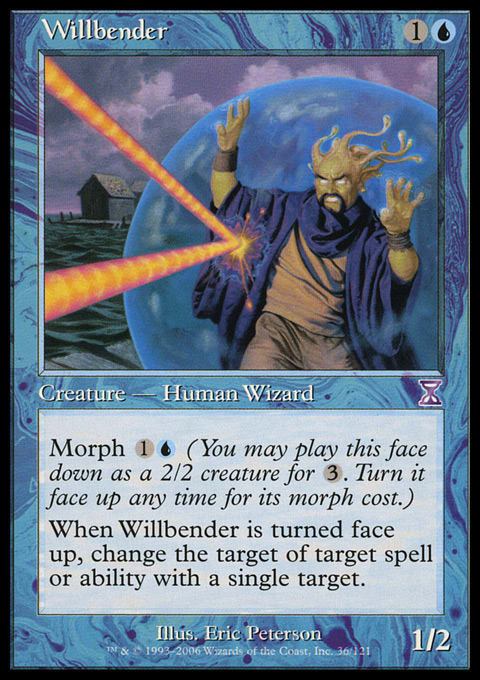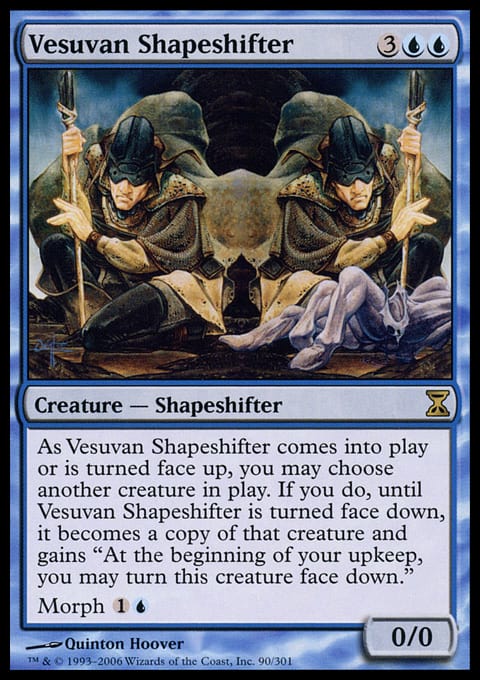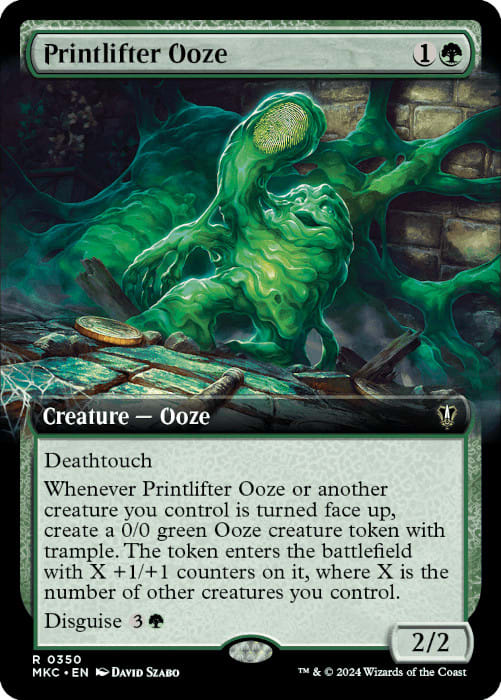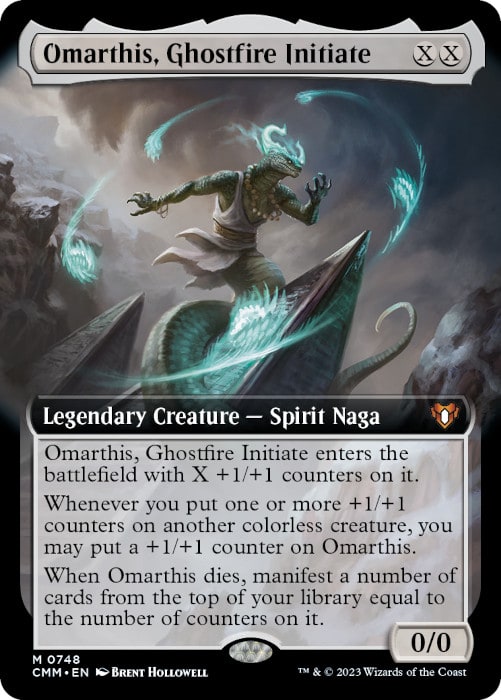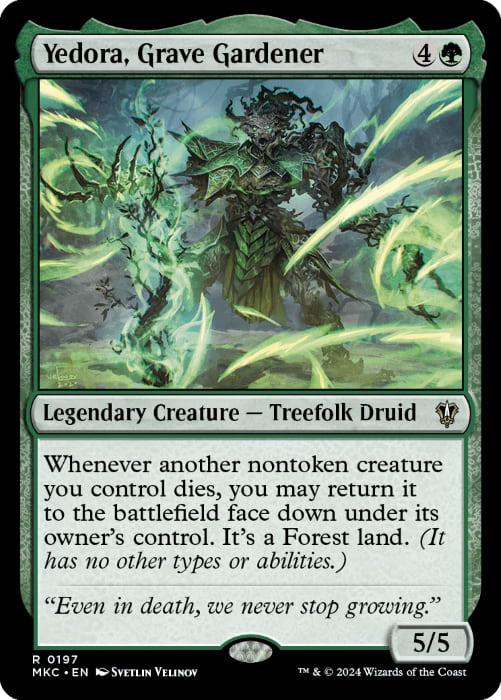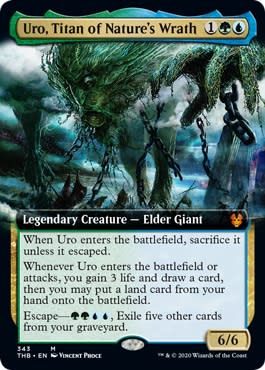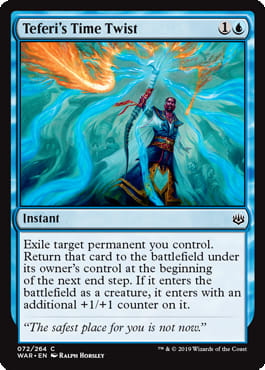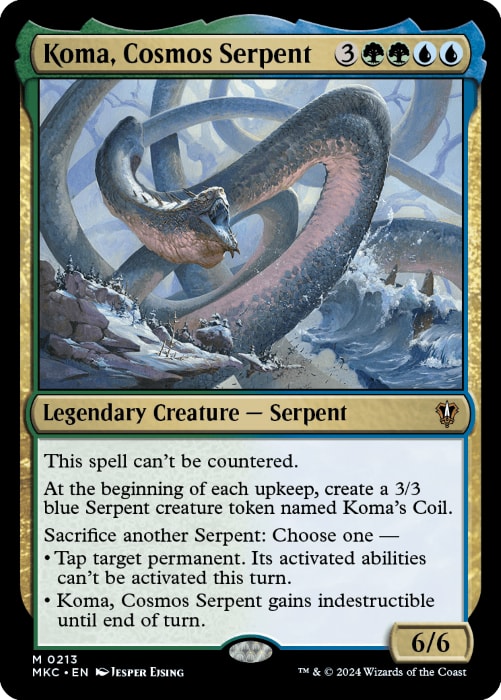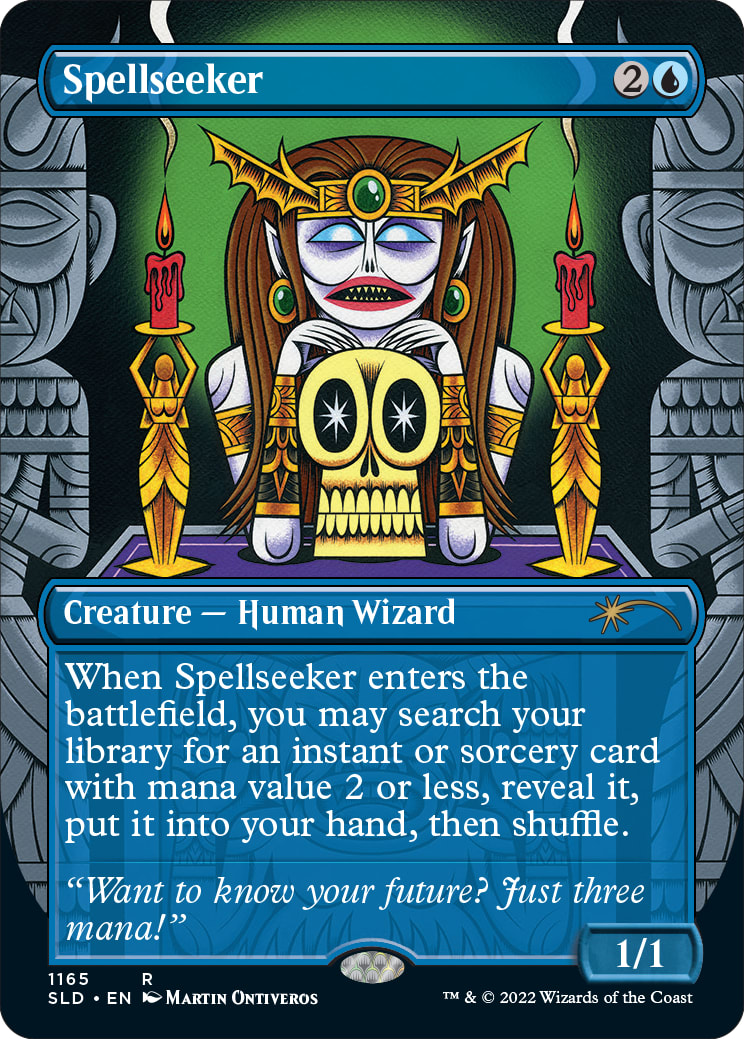The first time I heard about Murders at Karlov Manor, I was pretty excited. A top-down set based around the mystery genre sounded incredible to me. While I'm not well read on the classics, I grew up on the Ace Attorney series, and Umineko: When They Cry is one of my favorite ever works of fiction. As excited as I was, though, I tried to keep my expectations in check. Mystery storytelling is unique in a lot of ways, and I wasn't sure if the set would be able to successfully capture what makes it work.
Thankfully, coming out of spoiler season, I'm quite pleased with the set's execution, especially in regard to the way it uses hidden information. The morph mechanic has been beloved since its inception, and MKM's design prominently features disguise and cloak, new mechanics that take heavy inspiration from it. One of morph's greatest successes is the way it rewards game knowledge. An experienced player can see you cast a face down card, look at the rest of your deck, and make an educated guess on what that card is. In some circumstances being able to make that guess correctly can be the difference between winning or losing. This makes it an extremely engaging mechanic to play both with and against, and it makes an enormous contribution to the set's mystery feel. When I saw there was a legendary creature that interacts with cloak, my wheels immediately began to spin.
Vannifar, Evolved Enigma is a four-mana elf ooze wizard in Simic (![]()
![]() ) colors, with a decent 3/4 statline for her cost. At the beginning of combat on your turn, she'll let you choose between either cloaking a card from your hand, putting it onto the battlefield as a 2/2 creature with ward 2, or putting a +1/+1 counter on each colorless creature you control. Both options are powerful, and they synergize with one another quite nicely, since face down creatures are colorless. Vannifar can make an excellent commander for a morph deck, but that's not all she's capable of.
) colors, with a decent 3/4 statline for her cost. At the beginning of combat on your turn, she'll let you choose between either cloaking a card from your hand, putting it onto the battlefield as a 2/2 creature with ward 2, or putting a +1/+1 counter on each colorless creature you control. Both options are powerful, and they synergize with one another quite nicely, since face down creatures are colorless. Vannifar can make an excellent commander for a morph deck, but that's not all she's capable of.
Cloak, like manifest before it, has a unique and powerful interaction with flicker effects. When a face down permanent card is exiled and returned to the battlefield, it enters face up, allowing you to cheat it into play without paying its mana cost. With flicker spells being commonplace in Blue, this can make Vannifar a powerful way to cheat out expensive permanents, often at instant speed, giving your opponents very little time to react to your now threatening board. This game plan exists in parallel to our morph strategy, and that's part of what makes it work. Our opponents can see our board of face down creatures and have no idea how much danger they're in. Those cards could just as easily be game ending threats as they could be excess lands we're laying down to chump block with.
Making the Most of Morph
The morph strategy is a bit more straightforward, so we'll start with some of the cards that interact with that.
Willbender is the first card I think of when I think of morph. On the battlefield it's nothing special, only a vanilla 1/2 for two mana, but that isn't what anyone's playing it for. When you turn it face up for two mana, it can change the target of a single-target spell or ability. You can use it to save Vannifar from a removal spell, steal a draw spell like Blue Sun's Zenith, or save yourself from targeted damage. If you include the cost of a morph spell, this effect will normally cost you five mana over two turns, but conveniently, Vannifar can allow us to ignore that cost, putting Willbender onto the battlefield face down for free, and with ward 2, to boot. For only two mana, this effect is incredible, especially since it bypasses most countermagic. Turning a creature face-up is considered a special action, bypassing the stack completely. This has a lot of interesting implications I'm not qualified to dive into, but the important thing here is that Willbender's redirection is a triggered ability, making it difficult to interact with.
Megamorph is a mechanic I have strong feelings on, and those feelings aren't entirely rational. When Dragons of Tarkir released, I was a quite new player, and I was extremely excited. I loved Fate Reforged. Manifest took face down creatures in an entirely new direction, and I couldn't wait to see what the next set would do with them. Needless to say, I wasn't thrilled when the answer turned out to be morph again, but as Megamorph, giving the creature a +1/+1 counter. Nowadays, I'm more neutral on Megamorph. It plays well and feels distinct enough from its counterparts to justify its existence, it just didn't live up to my personal hype. I've always liked Den Protector, though. A take on Eternal Witness, it returns a card from your graveyard to your hand when it turns face up, which only costs two mana. Five mana is a perfectly reasonable price to pay for a 3/2 Eternal Witness, and that only makes Vannifar bypassing more than half the cost even better.
An unassuming but powerful morph payoff, Vesuvan Shapeshifter might be one of the format's most underlooked clones. It can become a copy of any creature on the battlefield as it enters the battlefield or is turned face up, but it has a key difference. At the beginning of your upkeep, you can turn it face down again, which can then allow you to turn it face up and copy something else. Very few clone effects can change what they're copying repeatedly, and Vesuvan Shapeshifter's ability to become a copy of another creature without involving the stack at all can be exceptionally strong. It also interacts extremely well with our other morph cards, since it can trigger their abilities if it turns face up to copy one of them.
Printlifter Ooze is a Green creature from the new Deadly Disguise preconstructed deck with disguise, a keyword ability, and a triggered ability that rewards you for turning creatures face up with +1/+1 counters. It also has a decent 2/2 statline and deathtouch, one of the best keywords a disguise creature could have. When it or another one of your creatures is turned face up, you create an ooze token with trample and a +1/+1 counter for each other creature you control. This effect can quickly help you flood the board, and Vannifar can be used to bypass the card's expensive disguise cost of four. A cloaked creature can be turned face-up for its mana cost (two in this case), even if it can also be turned face-up by other means.
Experiment Twelve is a green creature from Deadly Disguise with disguise, a keyword ability, and a triggered ability that rewards you for turning creatures face up with +1/+1 counters. I don't know why these two cards are oddly similar, but in practice, they play fairly differently. Experiment Twelve is significantly beefier as a 4/4 with trample, and instead of creating tokens, it gives a creature a number of counters equal to its power. This elf lizard warrior is an impressive payoff card for our strategy, significantly improving our ability to make our 2/2s much larger in the middle of combat, and it can very quickly reach a point of absurdity if you have a way to trigger this ability on the same creature multiple times.
Originating as the backup commander from the first colorless preconstructed deck, Omarthis, Ghostfire Initiate is an interesting commander in their own right, but also fits perfectly into this deck. A spirit naga snake with a mana cost of XX, Omarthis is a 0/0 that enters with X +1/+1 counters. When you put +1/+1 counters on another colorless creature, you can also put one on Omarthis, and when they die, you can manifest a card from the top of your library for each counter on them. With only a few other colorless creatures, you can stack counters on Omarthis extremely quickly by using Vannifar's +1/+1 counter ability, and when they die, they create an army of creatures you can continue to put counters on, some of which will be big things you can flicker or morph creatures you can flip.
Yedora, Grave Gardener is a very unique card, in a lot of respects. As a five mana 5/5, she's decently sized, but her strength lies primarily in her triggered ability. When another creature dies, she can return it to the battlefield face down as a forest. On top of being a strange form of ramp, these face down forests can be turned face-up if the creature in question has a morph ability, effectively resulting in an even stranger form of board protection. Yedora is delightfully odd, and while she'd definitely be better in a deck with more sacrifice outlets, she's still an excellent option.
A commander staple which just saw a reprint in Ravnica Remastered, Guardian Project is one of Green's best card draw engines. It's a four mana enchantment that allows you to draw a card when a nontoken creature enters the battlefield, but only if it doesn't share a name with another creature you control or have in your graveyard. This restriction is an almost complete non-factor in a singleton format, but the way it's worded is quite important for this deck. Because face down creatures are nameless, and aren't tokens, cloaked cards will always trigger this card draw. Between Vannifar and all of our flicker effects, this deck is shockingly good at dumping cards onto the battlefield, and thus drawing more cards.
One of the many planeswalkers first printed in War of the Spark, Ugin, the Ineffable is as powerful as he is perplexing. His +1 ability creates an oddly complicated 2/2 spirit token that exiles the top card of your library and puts that card in your hand when it leaves the battlefield. The fact that this ability doesn't just manifest the card drives me up the wall, but that aside, it's quite a strong loyalty ability. Alternatively, Ugin's -3 ability can destroy a permanent with one or more colors. Having removal on a loyalty ability is an excellent trait for a planeswalker to have, especially since, with a starting loyalty of 4, he can survive activating it immediately. Beyond all of that, he'll also passively reduce the cost of your colorless spells by 2. This will apply to all your artifacts, a smattering of other colorless cards, and will also reduce the cost of playing a face down card to a single mana.
Retired from his days of terrorizing 60 card formats, Uro, Titan of Nature's Wrath has found a niche in Commander as a powerful self-recurring value engine. He's technically a three mana 6/6, but he sacrifices himself when he enters the battlefield if he wasn't escaped. When he escapes from your graveyard for four mana and five exiled cards, you'll get an impressively sized beater that gains you 3 life, draws a card, and puts a land from your hand onto the battlefield when he enters or attacks. He's strong, but he typically requires seven mana to get into play. If we cloak him onto the battlefield with Vannifar, we can ignore his ETB triggers. You'll miss out on a card and a land, but you'll also get him onto the battlefield for only three mana.
Fun with Flickering
For our flicker gameplan, we'll need both flicker cards and the things we plan to use them on. Most of our flicker spells are functionally quite similar, so I won't be going over them individually. They're instants, generally cost two to three mana, and briefly exile one or two permanents. That said, there is one I'd like to give special mention to.
On top of sounding like the name of a dance move, Teferi's Time Twist is also one of the most overlooked flicker spells in the format. A two mana instant, it can exile any permanent you control until the next end step. If it's a creature, it returns to the battlefield with a +1/+1 counter on it. While flicker spells can be a useful way to dodge removal, they usually have a few limitations that Teferi's Time Twist lacks. Very few can target any permanent, and against spells that don't target, most flicker effects can't do much, since they return their target to the battlefield immediately. By delaying the return to the next end step, this spell can allow a key permanent to dodge a Wrath of God or a Council's Judgment. Of course, this card can also fulfill the same function as the rest of our flicker spells, cheating out our big payoff cards with Vannifar.
Speaking of big payoff cards, Nezahal, Primal Tide is exactly that. With a hulking statline of 7/7, this seven mana elder dinosaur doubles as a card draw engine, as well as being a threatening creature. By drawing you a card whenever an opponent casts a noncreature spell, Nezahal acts like a better Mystic Remora. Nezahal also removes your maximum hand size, but that won't do much for this deck, as cloaking cards with Vannifar can empty your hand shockingly quickly. Beyond that, they also protect themselves quite well, between being uncounterable and having the ability to discard three cards to flicker it.
Koma, Cosmos Serpent is infamous for how quickly it can flood the board and overwhelm the competition. A seven mana 6/6, Koma creates a 3/3 serpent token at the beginning of each upkeep. Not your upkeep. Every upkeep. If Koma survives even a single turn cycle, they can generate a small army of sizable creatures. Naturally, playing a creature this powerful is going to attract a lot of attention. When your opponents feel threatened by a card, they'll try to deal with that threat, whether it's by removing the card, or removing you from the game. Koma can deal with both. By sacrificing a serpent, they can either gain indestructible or tap a permanent and disable its activated abilities. Indestructibility makes Koma significantly more difficult to remove, and the tap ability can prevent creatures from attacking you, or disable key combo pieces.
Not all of the cards that synergize with our flicker spells are big, exciting creatures. Some of them just have powerful ETB abilities. Spellseeker is a perfect example. As a three mana 1/1, it has underwhelming stats, but that's only because most of its power budget went to its ability. When it enters the battlefield, you can search your library for an instant or sorcery spell with mana value two or less, and put it into your hand. This can tutor for a flicker spell, countermagic, board protection, removal, even a board wipe in Cyclonic Rift.
This next card is involved in a favorite interaction of mine. When you flicker an aura, it returns to the battlefield attached to something, but crucially, it doesn't target anything. This can allow aura-based removal to completely bypass hexproof and shroud, giving it a valuable niche. Unfortunately, very few flicker effects can target auras, but Vannifar fixes that by making them creatures. Song of the Dryads is a phenomenal removal spell for three mana, transforming whatever it enchants into an ordinary forest. While it's vulnerable to enchantment removal, the ability to remove someone's commander from play until further notice is extremely powerful. We can also utilize this at instant speed, since most of our flicker effects can be used at any time.
Roaming Throne is a card I've already talked about three times in recent columns. I swear, this is the last time I'm mentioning it. Copying triggered abilities is extremely powerful, and cards like this tend to attract removal, making ward quite valuable on it. The main reason I'm covering this card again is because I wanted to mention the fact that all three of Vannifar's creature types are reasonable options to choose. Willbender and Spellseeker are wizards, Experiment Twelve is an elf, and Printlifter Ooze is, shockingly, an ooze. All four of those cards can benefit significantly from Roaming Throne, so the creature type you name with it will depend heavily on which of them you've drawn that game. Regardless of that choice, it'll still double Vannifar's triggered ability, allowing you to dump your hand and create +1/+1 counters at twice the rate.
At the intersection of our gameplans, we find cards like Myr Battlesphere. This seven mana artifact creature creates four colorless 1/1 myr when it enters the battlefield, building a massive board Vannifar can load up with +1/+1 counters. It also has an ability that triggers when it attacks, allowing you to tap your other myr to buff your Battlesphere and damage whatever it's attacking. This deck won't use that ability terribly often, since our myr will often contribute more damage if they just attack. Myr Battlesphere works well whether you hardcast it or cheat it out, and whether you flicker it or not, and it'll help you create an alarming board state no matter what you do with it.
Brood Monitor isn't quite as good as Myr Battlesphere, but it does a reasonable job at filling the same role. When it enters the battlefield, it creates three 1/1 eldrazi scions alongside its own 3/3 body, creating four creatures and 6/6 in stats for its mana cost of six. Notably, Vannifar can give all four of these creatures +1/+1 counters, as despite its Green mana cost, devoid makes Brood Monitor count as a colorless creature. (Sidenote: I'm not calling it a colorless card that costs Green mana, that's stupid. Devoid cards are obviously designed as the colors they cost, and because of that, they rob the eldrazi of their mystique.) As eldrazi scions, the tokens can be sacrificed for colorless mana, though I can't imagine doing that often in this deck. You'll usually be better off swinging them at someone.
Glasspool Mimic // Glasspool Shore is a card I consider shockingly underrated. Modal dual faced cards (MDFCs, for short) are unique, allowing you to freely play either side from your hand, and Glasspool Mimic is an MDFC that can also be played as a land. I include one to three cards of that description in most of my decks, as playing cards that can either be lands or non-lands can help hedge against both mana screw and mana flood. To compensate for that strength, most MDFCs have a middling power level if you ignore their versatility. Glasspool Mimic, for example, is a mirror image of Mirror Image, an uncommon from Core 2019. Both are three mana clones that enter as a copy of a creature you control, but being an MDFC makes Glasspool Mimic magnitudes better. This card excels in any deck that would normally want to play a clone - namely decks that use a lot of non-legendary creatures with strong ETB or triggered abilities.
The Deck
I've really enjoyed this deck, for the most part, but I can tell there are improvements to be made. As I've noted multiple times, we can easily dump our hand onto the table, but after doing so, it can be easy to run out of gas if we get hit with a board wipe, or can't access card draw. I also think the connecting points between our game plans feel a bit disjointed. Outside of those issues, I'm happy with how this deck turned out. Vannifar is a powerful card, and she can single-handedly generate a fairly impressive board presence. Everything else we do serves to support, protect, and build off of her capabilities. I really enjoy her play patterns, and I'll probably continue to tune this deck over time.
Vannifar, Evolved Enigma | Commander | Lilian Johnson
- Commander (1)
- 1 Vannifar, Evolved Enigma
- Planeswalkers (1)
- 1 Ugin, the Ineffable
- Creatures (27)
- 1 Ainok Survivalist
- 1 Birds of Paradise
- 1 Brood Monitor
- 1 Consecrated Sphinx
- 1 Delighted Halfling
- 1 Den Protector
- 1 Displacer Kitten
- 1 Eternal Witness
- 1 Experiment Twelve
- 1 Glasspool Mimic
- 1 Ixidron
- 1 Koma, Cosmos Serpent
- 1 Mulldrifter
- 1 Myr Battlesphere
- 1 Nephalia Smuggler
- 1 Nezahal, Primal Tide
- 1 Omarthis, Ghostfire Initiate
- 1 Printlifter Ooze
- 1 Roaming Throne
- 1 Skullwinder
- 1 Spellseeker
- 1 Stratus Dancer
- 1 Thassa, Deep-Dwelling
- 1 Uro, Titan of Nature's Wrath
- 1 Vesuvan Shapeshifter
- 1 Willbender
- 1 Yedora, Grave Gardener
- Sorceries (4)
- 1 All is Dust
- 1 Bala Ged Recovery // Bala Ged Sanctuary
- 1 Nature's Lore
- 1 Three Visits
- Instants (13)
- 1 Arcane Denial
- 1 Beast Within
- 1 Blur
- 1 Counterspell
- 1 Cyclonic Rift
- 1 Displace
- 1 Essence Flux
- 1 Ghostly Flicker
- 1 Heroic Intervention
- 1 Illusionist's Stratagem
- 1 Planar Incision
- 1 Reality Shift
- 1 Teferi's Time Twist
- Enchantments (9)
- 1 Guardian Project
- 1 Imprisoned in the Moon
- 1 Mind's Dilation
- 1 Omniscience
- 1 Secret Plans
- 1 Song of the Dryads
- 1 Trail of Mystery
- 1 Ugin's Mastery
- 1 Virtue of Knowledge
- Artifacts (8)
- 1 Arcane Signet
- 1 Conjurer's Closet
- 1 Golden Argosy
- 1 Panoptic Projektor
- 1 Portal to Phyrexia
- 1 Scroll of Fate
- 1 Sol Ring
- 1 Talisman of Curiosity
- Lands (37)
- 9 Forest
- 10 Island
- 1 Barkchannel Pathway // Tidechannel Pathway
- 1 Branch of Vitu-Ghazi
- 1 Breeding Pool
- 1 Command Beacon
- 1 Command Tower
- 1 Demolition Field
- 1 Dreamroot Cascade
- 1 Flooded Grove
- 1 Hedge Maze
- 1 Hinterland Harbor
- 1 Pit of Offerings
- 1 Rejuvenating Springs
- 1 Rivendell
- 1 Simic Growth Chamber
- 1 Spawning Bed
- 1 Volatile Fault
- 1 Yavimaya Coast
- 1 Zoetic Cavern
Final Thoughts
I really like Vannifar. I always have. I love that the Simic are led by a jellyfish wizard. Her first card, Prime Speaker Vannifar, disappointed me. Having Birthing Pod as a commander is powerful, but it can lead to games feeling fairly samey. I'm glad I can now play a Vannifar deck that doesn't have that problem. Evolved Enigma also has some of my favorite Magic art in a while. All three versions of Vannifar look stunning, but I'm especially fond of Uriah Voth's piece. The way her dress is drawn is absolutely hypnotizing, and the way she glows in the darkness evokes deep sea photography of actual jellyfish.
While I'm under no delusion that this is the best Vannifar deck around, I enjoyed the experience of constructing and playing it. No matter the power level, she's a really fun commander. Playing around hidden information is a crucial element of both Magic and the Commander format, and the cloak mechanic excels at creating multiplayer games with interesting dynamics. Every card you cloak could be either a game ending threat or a basic land. It just depends on how much you're bluffing.
Morph, manifest, disguise, cloak... as similar as all these mechanics are, their differences are still significant. Many newer players struggle to understand their intricacies and interactions, and some might call the distinctions unnecessary complexity. However, much like Magic as a whole, that complexity contributes to their depth. I'll see you next week.

















